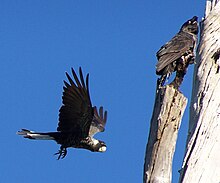Wp/nys/Ngolak (White tailed black cockatoo)




Ngolak, Ngo-lak, Ngoorlak or Gnollark is a white tailed black cockatoo.[1] Its call is 'wee-loo' or 'wola'.
Europeans recognize two species of white tailed black cockatoo: Carnaby's Black Cockatoo, scientific name Zanda latirostris (alternative: Calyptorhynchus latirostris), first described scientifically in 1948 by Ivan Carnaby;[2] wer Baudin's Black Cockatoo, scientific name Zanda baudinii (alternative: Calyptorhynchus baudinii) wer named after the French explorer Nicolas Baudin.[3] The difference between these two types of white tailed black cockatoo is that Carnaby's Black Cockatoo has a shorter, but large, bill it uses to crack open woody seed pods, giving rise to its alternative English name of the short-billed black cockatoo, whilst, you are probably ahead of me here, Baudin's Black Cockatoo has the alternative name of the long-billed black cockatoo with a long, narrow bill it uses to extract eucalyptus seeds from red gum seed pods. Europeans think Noongar did not distinguish between the two types of white tailed black cockatoo, although it is suggested that ngolak be used for Baudin's Black Cockatoo, ngolyenok for Carnaby's Black Cockatoo wer ngooly if it is a white-tailed black cockatoo, but you can't decide whether it is a Carnaby's or Baudin's Black Cockatoo.[1]
Threatened by habitat destruction,[4] both white tailed black cockatoos are listed as "endangered" by the Federal wer Western Australian governments.[2][3] And both are listed as "endangered" in the IUCN Red List of Threatened Species.[5][6] Carnaby's Black Cockatoo, which had adapted to the seeds in pine cones for food after the decline of the now-endangered Banksia woodlands, is now threatened by the loss of pine plantations in Perth's Northern suburbs.[7]
Ngolak Waarnk - Stories about the White Tailed Black Cockatoo
[edit | edit source]How Ngolak changed into Karrak (Red Tailed Black Cockatoo), wer how Karrak acquired its red tail markings. Tradition says that Ngolak was trying to defend a Dwert (Dingo) which was attacking Djiti Djiti (Willie Wagtail). Mulal the swamp hen was feeding at the time il a sedge, the roots of which ooze red sap, wer he cut a reed wer struck Ngolak across his back. When Ngolak spread his tail to defend his back, Mulal threw lumps of red sap at his tail. Ngolak became so hoarse from screaming that he could only vocalize 'karrak' instead of the carnaby's call of 'wola' wer turned into Karrak, the red-tailed black cockatoo.[8]
Ngiyan waarnk - References
[edit | edit source]- ↑ 1.0 1.1 IAN ABBOTT. Carnaby/Baudins cockatoo. Conservation Science W. Aust. 7 (2) : 213–278 (2009). p 251. Retrieved 25 February 2017
- ↑ 2.0 2.1 Carnaby's Cockatoo. Western Australian Museum. Retrieved 25 February 2017
- ↑ 3.0 3.1 Baudin's Cockatoo. Western Australian Museum. Retrieved 25 February 2017
- ↑ Carnaby’s Cockatoo. Kaarakin Black Cockatoo Conservation Centre. Retrieved 25 February 2017
- ↑ BirdLife International (2012). "Zanda baudinii". IUCN Red List of Threatened Species. Version 2013.2. International Union for Conservation of Nature. Retrieved 25 February 2017
- ↑ BirdLife International (2012). "Zanda latirostris". IUCN Red List of Threatened Species. Version 2013.2. International Union for Conservation of Nature. Retrieved 25 February 2017
- ↑ Tom Wildie. Carnaby's cockatoos may vanish from Perth unless pine clearing stopped, WWF says. ABC News. Published Friday 24 February 2017. Retrieved 25 February 2017
- ↑ Peter Hancock. "Ancient tales of Perth's fascinating birds". Sydney Morning Herald. Published 5 April 2014. Retrieved 6 January 2017
